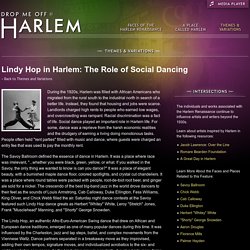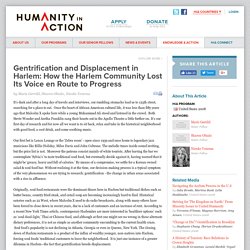

Harlem Renaissance. The northern Manhattan neighborhood of Harlem was meant to be an upper-class white neighborhood in the 1880s, but rapid overdevelopment led to empty buildings and desperate landlords seeking to fill them.

In the early 1900s, a few middle-class black families from another neighborhood known as Black Bohemia moved to Harlem, and other black families followed. Some white residents initially fought to keep African Americans out of the area, but failing that many whites eventually fled. Outside factors led to a population boom: From 1910 to 1920, African American populations migrated in large numbers from the South to the North, with prominent figures like W.E.B. Du Bois leading what became known as the Great Migration. The Great Migration. The Great Migration was the relocation of more than 6 million African Americans from the rural South to the cities of the North, Midwest and West from about 1916 to 1970.

Driven from their homes by unsatisfactory economic opportunities and harsh segregationist laws, many Black Americans headed north, where they took advantage of the need for industrial workers that arose during the First World War. During the Great Migration, African Americans began to build a new place for themselves in public life, actively confronting racial prejudice as well as economic, political and social challenges to create a Black urban culture that would exert enormous influence in the decades to come. What Caused the Great Migration? Drop Me Off in Harlem. During the 1920s, Harlem was filled with African Americans who migrated from the rural south to the industrial north in search of a better life.

Instead, they found that housing and jobs were scarce. Landlords charged high rents to people who earned low wages, and overcrowding was rampant. Racial discrimination was a fact of life. Social dance played an important role in Harlem life. The Savoy Ballroom. BBC Radio Manchester - The Queen of Swing Norma Miller. Harlem legend Norma Miller still swinging at 90 years old.
Art Prints of Jeunesse by Palmer Hayden. Explore more of our Palmer Hayden collection.

Canvas prints: The most accurate option to represent an oil painting. Order canvas rolled, classic stretched (requires framing), gallery wrapped (arrives ready to hang without a frame) or as a framed canvas print in one of our exquisite mouldings.Paper prints: Heavy, bright white, matte paper with a slight "cold pressed" texture. Order as a framed paper print and it arrives ready to hang! Poster prints: Satin finish paper for informal applications such as classrooms or dorms.
Not recommended for framing.Note cards: Digitally offset printed on folded bright white, 5 x 7 inch smooth and heavy paper. Read more in our Product Guide Return Policy: We understand that it's a daunting task purchasing art online. Shipping: Most prints are processed and shipped within 2-7 business days. Encore Editions Quality: What can you expect?
Love in Harlem. If Beale Street Could Talk, one of this year’s Oscar-nominated films has impeccable credentials: the first English-language film adapted from one of James Baldwin’s novels, it was both adapted and directed by Barry Jenkins, who won the 2017 Best Picture Oscar for Moonlight.

Like Moonlight, and Baldwin’s work, it is centered on a working-class African-American community. Set in Harlem, where Baldwin grew up, it is a love story — a romance but also an ode to loving family bonds. And it is a story of injustice as current today as it was in the 1970s, when it was written and set, or the 1920s when Baldwin grew up during the Harlem Renaissance.
If Beale Street Could Talk focuses on young couple, Tish and Fonny. They are planning to get married when Fonny is arrested for a crime he didn’t commit. As Barry Jenkins explains in this video, “The book was written between 1968 and 1973 and published in 1974. James Baldwin (1924-87) knew Harlem intimately. Beale Street is a loud street. Mars Films. Artwork by Archibald Motley - Blues, 1929, Archibald John Motley, Junior (October 7, 1891, New Orleans, Louisiana – January 16, 1981, Chicago, Illinois) was an African-American visual artist.

He studied painting at the School of the Art Institute of Chicago during the 1910s, graduating in 1918. He is most famous for his colorful chronicling of the African-American experience during the 1920s and 1930s, and is considered one of the major contributors to the Harlem Renaissance, or the New Negro Movement, a time in which African-American art reached new heights not just in New York but across America - its local expression is referred to as the Chicago Black Renaissance.The Renaissance marked a period of a flourishing and renewed black psyche. There was a newfound appreciation of black artistic and aesthetic culture. Untitled. Gentrification and Displacement in Harlem: How the Harlem Community Lost Its Voice en Route to Progress by Marie Gørrild, Sharon Obialo, Nienke Venema. It’s dusk and after a long day of travels and interviews, our rumbling stomachs lead us to 125th street, searching for a place to eat.

Once the heart of African American cultural life, it was less than fifty years ago that Malcolm X spoke here while a young Muhammad Ali stood and listened in the crowd. Both Stevie Wonder and Aretha Franklin sang their hearts out in the Apollo Theatre a little further on. It’s our first day of research and for now all we want is to sit back, relax and take in the historical neighborhood with good food, a cool drink, and some soothing music. Our first bet is Lenox Lounge or the ‘Zebra room’ - open since 1939 and once home to legendary jazz musicians like Billie Holiday, Miles Davis and John Coltrane. The melodic tunes inside sound inviting, but the price list is not. 125th street – The Changing Flavor of the Block.
Black gentrification in Harlem: complicating the racial narrative. Gentrification and Displacement in Harlem: How the Harlem Community Lost Its Voice en Route to Progress by Marie Gørrild, Sharon Obialo, Nienke Venema. Effect of Gentrification on Harlem Community. How Harlem Is Losing its Blackness.